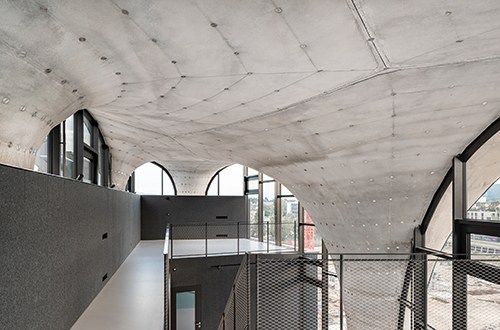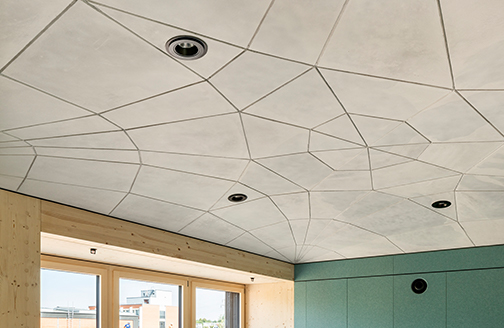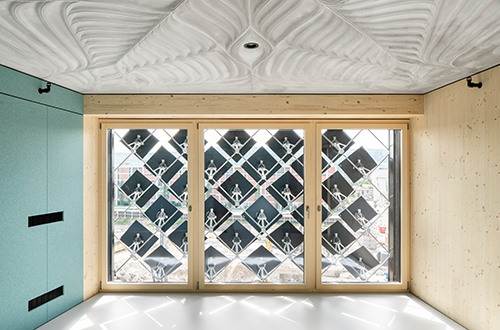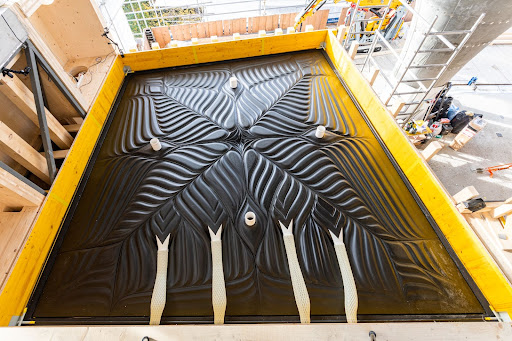HiLo
Following the principle of "High Performance – Low Emissions", NEST's HiLo unit demonstrates how attractive architecture can be when combining energy- and resource-saving construction and operation. The unit brings together innovative planning and design methods for efficient structures in concrete with self-learning and adaptive building technologies.
The construction industry is responsible for a large share of global resource and energy consumption and greenhouse gas emissions. At the same time, the construction sector is faced with a constantly growing world population. The HiLo Unit features innovations that address these challenges. The integrated design and fabrication approach used to build the two-story unit marks a starting point for the way we may design and build in the future.
The unit on the top platform of Empa's and Eawag's NEST research and innovation building was realized by ETH Zurich's Block Research Group and the Architecture and Building Systems Group in cooperation with numerous industrial partners.
ETH Zurich
ETH Foundation
Autodesk
Beckhoff
Belimo
Bouygues Energies & Services Schweiz AG
Bürgin Creations
Debrunner Acifer Bewehrungen AG
Delta Light
Doka Schweiz AG
Feller AG
Flisom AG
Haworth
Holcim
Impact Acoustic AG
Künzli Holz AG
Marti AG Bauunternehmung
Mensch und Maschine
Mitsubishi Electric R&D Centre Europe B.V.
NCCR Digital Fabrication
Pletscher Metallbau
R. Nussbaum AG
ROK
SageGlass
Sika AG
Supermanoeuvre
Vetrotech
The partners of the different project phases can be found here.
Press release on the opening
Here you find all publications about HiLo
The innovation objects in the HiLo unit

Flexibly formed concrete roof
HiLo’s roof is a doubly curved concrete sandwich structure consisting of two thin layers of reinforced concrete of only five and three centimeters thick. Spaced ten centimeters apart by insulation blocks, the layers are connected by a grid of thin compressive stiffening ribs and vertical tension rods. Combining this lightweight two-layered structure with the strength derived from its highly curved geometry, the roof stands freely on five supports, covering an unobstructed space of 120m2.
Non-standard concrete structures require custom formworks that typically use massive amounts of cut timber or milled foam as shuttering. The production of such single-use moulds is costly and wasteful. HiLo's roof structure was instead built using a flexible formwork, based on a largely reusable kit-of-parts. The primary structure of the formwork is a cable net consisting of individually cut cable segments connected at custom-designed nodes, tensioned within a wooden boundary frame. A thin fabric membrane is stretched over the cable net and connected to the nodes to form a taut surface onto which the concrete can be cast or sprayed.
The HiLo roof is an inspiration for how the building envelope can be rethought and the new possibilities resulting from the combination of traditional knowledge and digital methods.
Partner: ETH Zurich
Optimization of building systems
Architecture and building systems (A/S) at ETH Zurich is developing new methods for building control using machine learning. Optimizing system operation according to a control objective, which can be represented by the indoor environmental quality (IEQ), energy savings or a combination of metrics. Most recent novel control strategies are based either on a model predictive approach or artificial intelligence. This research project will investigate the use of machine learning to enhance the control of HVAC systems with a focus on occupant comfort.
Partners: ETH Zurich, Mitsubishi Electric

Funicular floor system
The innovative HiLo floors use a thin, doubly curved funicular shell with vertical stiffeners to transfer loads to the supports through compression forces only. The forces are accumulated in the corners, where their outward thrust is absorbed in post-tensioned ties.
By placing material only where it is structurally needed – following the flow of forces in compression and tension – and keeping all materials separable, the HiLo floor system saves more than 70% of concrete and 90% of reinforcement steel compared to the standard reinforced concrete slab, and allows for easy recycling at its end of life.
The HiLo floors are a first demonstration of these principles in a real-world building and provide an outlook at a real, disruptive opportunity to the construction industry for dramatically reducing carbon emissions – simply by replacing a wasteful component in the buildings all around us.
Partner: ETH Zurich
The innovative floor system is being further developed by Holcim in collaboration with ETH Zurich and is being brought to the market. Interested construction professionals can learn more about the innovative system and its application in their own projects in workshops.
DC instead of AC
Solar panels generate direct current (DC), which must be converted into alternating current (AC) for general use. Many end devices then convert this alternating current back to DC. These conversions are inefficient. In HiLo, as many household appliances and terminal devices as possible are directly connected to a DC network.
Partner: CSEM

Adaptive Solar Façade
The adaptive solar façade has been designed to exploit the potential of the building façade as an interface between inside and outside: Using rotatable, lightweight thin-film photovoltaic modules, it can continuously react to its environment by constantly optimizing the orientation of the modules on horizontal and vertical axes. At the same time, the modules are used to control the shading of the interior and the transparency of the façade to control solar gains, to allow passive heating or reduce cooling demand, and to ensure comfort. This can be done manually, but also automatically: The façade uses learning algorithms that learn to adapt optimally to the needs of the occupants while minimizing energy demand. It acts as an integral part of the building system, in interplay with other building technology components such as lighting, heating, and ventilation.
Partner: ETH Zurich

3D-printed formwork for integrated building systems
Through computational modelling, concrete building elements can be designed to integrate highly efficient low-energy building systems for heating, cooling and ventilation. Nevertheless, the topological complexity of these optimised designs cannot be physically realised using conventional flat panel formwork systems.
To tackle this limitation, an interdisciplinary team from Architecture and Buildings Systems and Digital Building Technologies at ETH Zurich developed an innovative concept for optimised thermally-active concrete slabs and an efficient 3D-printed formwork system for in-situ casting. The concrete slab produced with this method for HiLo acts as a highly efficient radiant ceiling due to its articulated surface. The thermal performance is further enhanced by an active 3D-printed ventilation system that distributes air inside the room with reduced energy requirements.
Partner: ETH Zurich

